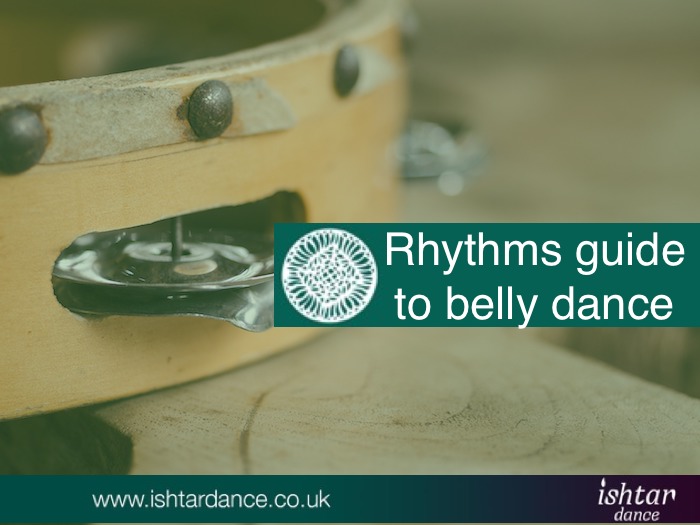Guide to belly dance rhythms
By Ishtar Dance on Monday, April, 1st, 2019 in Dance Coaching, Dance Inspiration, Learning 2 Comments
 Understanding and knowing rhythms is essential for dancers of any style, but surprisingly many belly dancers are never taught this. This makes it harder to learn the technical nuances needed for strong technique as well as for creating choreographies and not least improvising.
Understanding and knowing rhythms is essential for dancers of any style, but surprisingly many belly dancers are never taught this. This makes it harder to learn the technical nuances needed for strong technique as well as for creating choreographies and not least improvising.
You may think it’s only needed for professional or high level dancers, but even recreational dancers can benefit hugely from understanding the rhythems used in class. It can help them move more confidently and for those with a more academic brain, it can create a better understand the moves and sequences their learning. People have very different learning styles, so throwing too much detail about dums, taqs and maksoums in is not for everyone, but I always try to mention the name and the patterns of the rhythms no matter what level class I’m teaching, so students can take away from it what they need. Maybe because many of my early teacher never did.
I’m personally a very intuitive dancer, and I learned, probably like most, to know and anticipate the rhythms, and also which would follow next, simply by listening and not least dancing to lots of different Arabic music. I didn’t know the names, but I knew what they ‘felt’ like, which is equally important.
Checkout this video which goes through the different belly dance rhythms and shows not only the structure but also how you can move with them.
You may wonder why you should bothered learning more about the rhythms if you can already dance with relative ease to Arabic music, but there are several compelling reasons:
Cultural references
A good dancer should always make sure they use their music in the right way. If you’re a performer, this will mean cultural appropriation; knowing the background and culture it relates to and how to reflect this in your dancing as well as your costuming. If you’re dancing in a restaurant, this can help you pick your music, but also perform with confidence in front of those audience members who may know that song or genre, by clearly reflecting it in your dancing.
If you’re a teacher or creating your own choreography, it will help you to know what is and what isn’t ‘authentic’ and not least, why a dance or certain moves are performed the way they are. I say ‘authentic’ because I believe it’s ok to break the rules to help innovate and create ones own style. But in order to do that, you need to know the rules, and not least why they are there in the first place.
Fusion is a very good example of this. I see a lot of dancers who claim to perform/teach fusion, but they don’t all know the elements that they are fusing together. If you are creating for example a Salsa Belly Dance Fusion, you will need to know and not least have pretty good technique in both styles in order to couple them together well.
Improvising
When making up a dance, whether to be performances in front of an audience, or as a new and innovative choreography that you may teach others, it will help you immensely to know and understand your rhythms. It will help take the stress out of the moment, because you’ll recognise the building blocks needed to create your final piece of art. Think of it as Lego blocks; the rhythms being your 2s, 4s, 6s or 8 pieces, and the moves you put on top the different colours. It will also save you time in the planning process, because you’ll be able to more confidently pick the moves and combinations that go with the music.
Working with musicians
If you’re lucky enough to dance with a live drummer or even a whole band, then knowing your rhythms will really pay off. Not only will you be able to tell the drummer what rhythms you’d like, if for example creating a drum solo, but again it will allow you to communicate with the musicians easily. The dancer is the music in physical form, and will take cues from the music, but also likewise influence the musician creating it. This is in my heart how belly dancing should really be – a unique celebration of the music and a dialog between the people who bring it alive in that moment. I can only recommend to every dancer to try dancing with live musicians if an opportunity arises to do so in a welcoming and nurturing environment.
In depth learning
If you’d like to get a much deeper understanding of not only belly dance rhythms, but also the music and history that lies behind, including key composers and dancers, then join me for the JWAAD Music Course, which I will run in London this Summer/Autumn alongside my fellow JWAAD Teachers including Yasmina of Cairo. We will also work with a live drummer, learning not only the feel of the different rhythms and how they are created on the various drums, but also how to improvise and collaborate with a live musician. There are only a few places left so do register your interest as soon as possible, as the course is not likely to run again for another 12-18 months.
I hope you found this guide to belly dance rhythms useful and I hope you will share and not least comment below so I know how you’re getting on. How do you teach or use rhythms in your dancing? Do you actively think about it, and how did you get to know them in the first place? Let’s keep the knowledge sharing going for beautiful and confident dancing always 🙂
Dorte
Did you miss my last post? Read it here: How to use your head to move better

I definitely find that dancing to live musicians is a much better experience and one that all belly dancers should try if there is a chance.
I got to dance to live music on a belly dance trip to Cairo and one a trip to Morocco.
Great post!
xx
Hi Valeria, thank you for sharing. Yes dance trips are a great way to work with some amazing talented musicians and an excellent opportunity for dancers to explore the joy of dancing to live music. Hope you keep exploring and find more ways to dance with live musicians in the future 😉